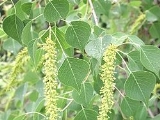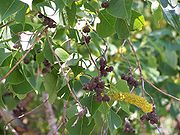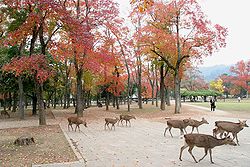
Chinese tallow
Encyclopedia
Sapium sebifera, formerly referred to as Triadica sebiferum, is commonly known as the Chinese tallow tree, Florida aspen, Chicken Tree, and Gray Popcorn Tree . The tree is native to eastern Asia
, and is most commonly associated with eastern China
, Taiwan
, and Japan
. In these regions, the waxy coating of the seeds is used for candle
and soap
making, and the leaves
are used as herbal medicine to treat boils. The plant sap
and leaves are reputed to be toxic, and decaying leaves from the plant are toxic to other species of plant
. The specific epithets sebifera and sebiferum mean "wax-bearing" and refer to the vegetable tallow that coats the seeds.
It is useful in the production of biodiesel
because it is the third most productive vegetable oil producing crop in the world, after algae
and oil palm
. This species is considered to be a noxious invader in the U.S.
 The waxy green leaves set off the clusters of greenish-yellow and white flower
The waxy green leaves set off the clusters of greenish-yellow and white flower
s at bloom time. The flowers occur in terminal spike-like inflorescence
s up to 20 cm long. Light green in color, these flowers are very conspicuous in the spring. Each pistillate (female) flower is solitary and has a three-lobed ovary, three styles, and no petals. They are located on short branches at the base of the spike. The staminate (male) flowers occur in clusters at the upper nodes of the inflorescence.
Fruits are three-lobed, three-valved capsules. As the capsules mature, their color changes from green to a brown-black. The capsule walls fall away and release three globose seeds with a white, tallow-containing covering. Seeds usually hang on the plants for several weeks. In North America
, the flowers typically mature from April to June and the fruit ripens from September to October.
 The plant is found throughout the southern United States
The plant is found throughout the southern United States
. Incorrectly thought to have been introduced in colonial times by Benjamin Franklin, the tree has become naturalized
from North Carolina
southward along the Atlantic
and the entire Gulf coast
, where it grows profusely along ditchbanks and dikes. It grows especially well in open fields and abandoned farmland, and along the edges of the Western Gulf coastal grasslands
biome, sometimes forming pure stands
. In the Houston area
, Chinese tallowtrees account for a full 23 percent of all trees, more than any other tree species and is the only invasive tree species in the 14 most common species in the area. Herbivores and insects have a conditioned behavioral avoidance to eating the leaves of Chinese tallowtree, and this, rather than plant toxins, may be a reason for the success of the plant as an invasive.
The plant is sold in nurseries
as an ornamental
tree. It is not choosy about soil
types or drainage
, but will not grow in deep shade. It commonly grows all over Japan, and is reasonably hardy. It is prized for its abundant and often spectacular autumn foliage.
The tree is common is SE Oklahoma as well; However it is not depicted on the map.
 The seed's white waxy aril is used in soap making. The seed's inner oil is toxic but has industrial applications.
The seed's white waxy aril is used in soap making. The seed's inner oil is toxic but has industrial applications.
The nectar is non-toxic, and it has become a major honey plant for beekeeper
s. The honey is of high quality, and is produced copiously during the month of June, on the Gulf Coast. In the Gulf coast states, beekeepers migrate with their honey bee
s to good tallow locations near the sea.
The tree is highly ornamental, fast growing and a good shade tree. It is especially noteworthy if grown in areas that have strong seasonal temperature ranges with the leaves becoming a multitude of colours rivaling maples in the autumn.
Asia
Asia is the world's largest and most populous continent, located primarily in the eastern and northern hemispheres. It covers 8.7% of the Earth's total surface area and with approximately 3.879 billion people, it hosts 60% of the world's current human population...
, and is most commonly associated with eastern China
China
Chinese civilization may refer to:* China for more general discussion of the country.* Chinese culture* Greater China, the transnational community of ethnic Chinese.* History of China* Sinosphere, the area historically affected by Chinese culture...
, Taiwan
Taiwan
Taiwan , also known, especially in the past, as Formosa , is the largest island of the same-named island group of East Asia in the western Pacific Ocean and located off the southeastern coast of mainland China. The island forms over 99% of the current territory of the Republic of China following...
, and Japan
Japan
Japan is an island nation in East Asia. Located in the Pacific Ocean, it lies to the east of the Sea of Japan, China, North Korea, South Korea and Russia, stretching from the Sea of Okhotsk in the north to the East China Sea and Taiwan in the south...
. In these regions, the waxy coating of the seeds is used for candle
Candle
A candle is a solid block or cylinder of wax with an embedded wick, which is lit to provide light, and sometimes heat.Today, most candles are made from paraffin. Candles can also be made from beeswax, soy, other plant waxes, and tallow...
and soap
Soap
In chemistry, soap is a salt of a fatty acid.IUPAC. "" Compendium of Chemical Terminology, 2nd ed. . Compiled by A. D. McNaught and A. Wilkinson. Blackwell Scientific Publications, Oxford . XML on-line corrected version: created by M. Nic, J. Jirat, B. Kosata; updates compiled by A. Jenkins. ISBN...
making, and the leaves
Leaf
A leaf is an organ of a vascular plant, as defined in botanical terms, and in particular in plant morphology. Foliage is a mass noun that refers to leaves as a feature of plants....
are used as herbal medicine to treat boils. The plant sap
Sap
Sap may refer to:* Plant sap, the fluid transported in xylem cells or phloem sieve tube elements of a plant* Sap , a village in the Dunajská Streda District of Slovakia...
and leaves are reputed to be toxic, and decaying leaves from the plant are toxic to other species of plant
Plant
Plants are living organisms belonging to the kingdom Plantae. Precise definitions of the kingdom vary, but as the term is used here, plants include familiar organisms such as trees, flowers, herbs, bushes, grasses, vines, ferns, mosses, and green algae. The group is also called green plants or...
. The specific epithets sebifera and sebiferum mean "wax-bearing" and refer to the vegetable tallow that coats the seeds.
It is useful in the production of biodiesel
Biodiesel
Biodiesel refers to a vegetable oil- or animal fat-based diesel fuel consisting of long-chain alkyl esters. Biodiesel is typically made by chemically reacting lipids with an alcohol....
because it is the third most productive vegetable oil producing crop in the world, after algae
Algae
Algae are a large and diverse group of simple, typically autotrophic organisms, ranging from unicellular to multicellular forms, such as the giant kelps that grow to 65 meters in length. They are photosynthetic like plants, and "simple" because their tissues are not organized into the many...
and oil palm
Oil palm
The oil palms comprise two species of the Arecaceae, or palm family. They are used in commercial agriculture in the production of palm oil. The African Oil Palm Elaeis guineensis is native to West Africa, occurring between Angola and Gambia, while the American Oil Palm Elaeis oleifera is native to...
. This species is considered to be a noxious invader in the U.S.
Physical characteristics
The simple, deciduous leaves of this tree are alternate, broad rhombic to ovate in shape and have smooth edges, heart shaped and sometimes with an extended tail often resembling the bo tree, Ficus religiosa. The leaves are bright green in color and slightly paler underneath. They become bright yellows, oranges, purples and reds in the autumn. The tree is monoecious, producing male and female flowers on the same plant.
Flower
A flower, sometimes known as a bloom or blossom, is the reproductive structure found in flowering plants . The biological function of a flower is to effect reproduction, usually by providing a mechanism for the union of sperm with eggs...
s at bloom time. The flowers occur in terminal spike-like inflorescence
Inflorescence
An inflorescence is a group or cluster of flowers arranged on a stem that is composed of a main branch or a complicated arrangement of branches. Strictly, it is the part of the shoot of seed plants where flowers are formed and which is accordingly modified...
s up to 20 cm long. Light green in color, these flowers are very conspicuous in the spring. Each pistillate (female) flower is solitary and has a three-lobed ovary, three styles, and no petals. They are located on short branches at the base of the spike. The staminate (male) flowers occur in clusters at the upper nodes of the inflorescence.
Fruits are three-lobed, three-valved capsules. As the capsules mature, their color changes from green to a brown-black. The capsule walls fall away and release three globose seeds with a white, tallow-containing covering. Seeds usually hang on the plants for several weeks. In North America
North America
North America is a continent wholly within the Northern Hemisphere and almost wholly within the Western Hemisphere. It is also considered a northern subcontinent of the Americas...
, the flowers typically mature from April to June and the fruit ripens from September to October.
Range and habitat

United States
The United States of America is a federal constitutional republic comprising fifty states and a federal district...
. Incorrectly thought to have been introduced in colonial times by Benjamin Franklin, the tree has become naturalized
Naturalisation (biology)
In biology, naturalisation is any process by which a non-native organism spreads into the wild and its reproduction is sufficient to maintain its population. Such populations are said to be naturalised....
from North Carolina
North Carolina
North Carolina is a state located in the southeastern United States. The state borders South Carolina and Georgia to the south, Tennessee to the west and Virginia to the north. North Carolina contains 100 counties. Its capital is Raleigh, and its largest city is Charlotte...
southward along the Atlantic
Atlantic Ocean
The Atlantic Ocean is the second-largest of the world's oceanic divisions. With a total area of about , it covers approximately 20% of the Earth's surface and about 26% of its water surface area...
and the entire Gulf coast
Gulf of Mexico
The Gulf of Mexico is a partially landlocked ocean basin largely surrounded by the North American continent and the island of Cuba. It is bounded on the northeast, north and northwest by the Gulf Coast of the United States, on the southwest and south by Mexico, and on the southeast by Cuba. In...
, where it grows profusely along ditchbanks and dikes. It grows especially well in open fields and abandoned farmland, and along the edges of the Western Gulf coastal grasslands
Western Gulf coastal grasslands
The Western Gulf coastal grasslands are a subtropical grassland ecoregion of the southern United States and northeastern Mexico. It is known in Texas as "Coastal Prairie" and as the Tamaulipan pastizal in Mexico.-Setting:...
biome, sometimes forming pure stands
Monoculture
Monoculture is the agricultural practice of producing or growing one single crop over a wide area. It is also known as a way of farming practice of growing large stands of a single species. It is widely used in modern industrial agriculture and its implementation has allowed for large harvests from...
. In the Houston area
Greater Houston
Houston–Sugar Land–Baytown is a 10-county metropolitan area defined by the Office of Management and Budget. It is located along the Gulf Coast region in the U.S. state of Texas...
, Chinese tallowtrees account for a full 23 percent of all trees, more than any other tree species and is the only invasive tree species in the 14 most common species in the area. Herbivores and insects have a conditioned behavioral avoidance to eating the leaves of Chinese tallowtree, and this, rather than plant toxins, may be a reason for the success of the plant as an invasive.
The plant is sold in nurseries
Nursery (horticulture)
A nursery is a place where plants are propagated and grown to usable size. They include retail nurseries which sell to the general public, wholesale nurseries which sell only to businesses such as other nurseries and to commercial gardeners, and private nurseries which supply the needs of...
as an ornamental
Ornamental plant
Ornamental plants are plants that are grown for decorative purposes in gardens and landscape design projects, as house plants, for cut flowers and specimen display...
tree. It is not choosy about soil
Soil
Soil is a natural body consisting of layers of mineral constituents of variable thicknesses, which differ from the parent materials in their morphological, physical, chemical, and mineralogical characteristics...
types or drainage
Drainage
Drainage is the natural or artificial removal of surface and sub-surface water from an area. Many agricultural soils need drainage to improve production or to manage water supplies.-Early history:...
, but will not grow in deep shade. It commonly grows all over Japan, and is reasonably hardy. It is prized for its abundant and often spectacular autumn foliage.
The tree is common is SE Oklahoma as well; However it is not depicted on the map.
Uses

The nectar is non-toxic, and it has become a major honey plant for beekeeper
Beekeeper
A beekeeper is a person who keeps honey bees for the purposes of securing commodities such as honey, beeswax, pollen, royal jelly; pollinating fruits and vegetables; raising queens and bees for sale to other farmers; and/or for purposes satisfying natural scientific curiosity...
s. The honey is of high quality, and is produced copiously during the month of June, on the Gulf Coast. In the Gulf coast states, beekeepers migrate with their honey bee
Honey bee
Honey bees are a subset of bees in the genus Apis, primarily distinguished by the production and storage of honey and the construction of perennial, colonial nests out of wax. Honey bees are the only extant members of the tribe Apini, all in the genus Apis...
s to good tallow locations near the sea.
The tree is highly ornamental, fast growing and a good shade tree. It is especially noteworthy if grown in areas that have strong seasonal temperature ranges with the leaves becoming a multitude of colours rivaling maples in the autumn.
External links
- University of Florida: Chinese tallow
- PLANTS Profile for Triadica sebifera
- ISSG Database entry for Triadica sebifera
- Species Profile- Chinese Tallow (Triadica sebifera), National Invasive Species Information Center, United States National Agricultural LibraryUnited States National Agricultural LibraryThe United States National Agricultural Library is one of the world's largest agricultural research libraries, and serves as a National Library of the United States and as the library of the United States Department of Agriculture...
. Lists general information and resources for Chinese Tallow.

